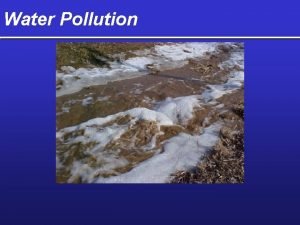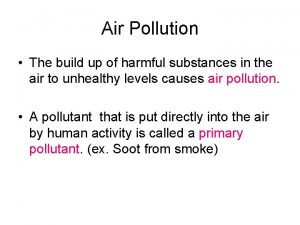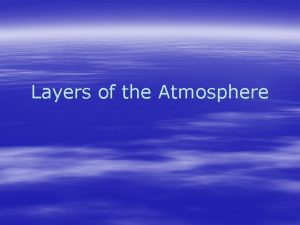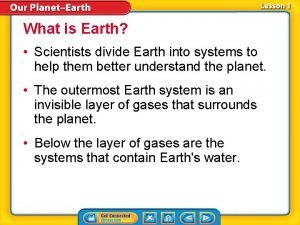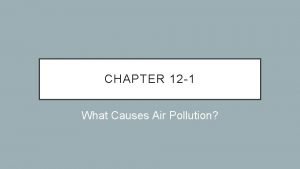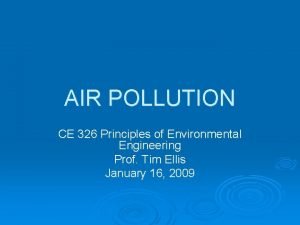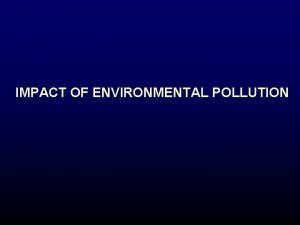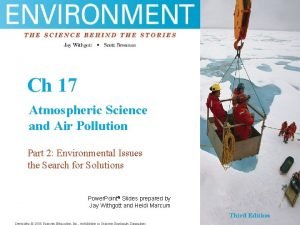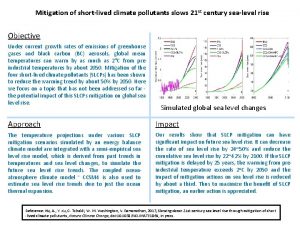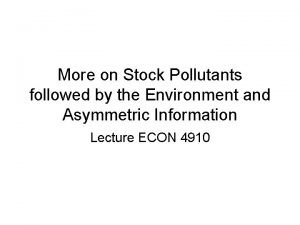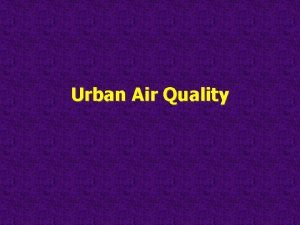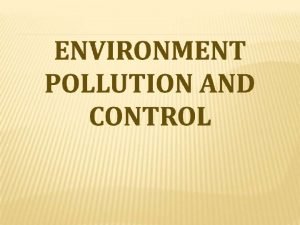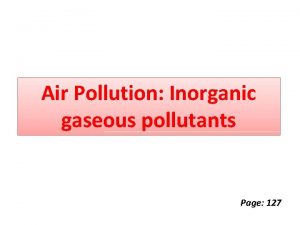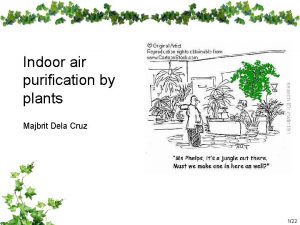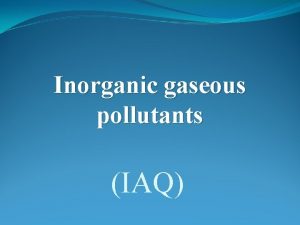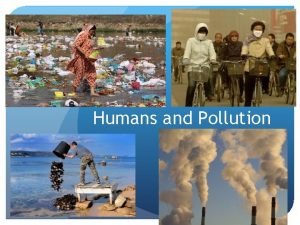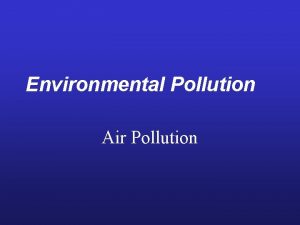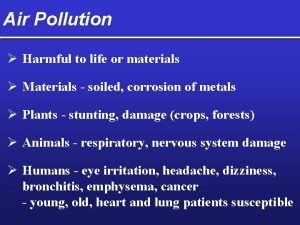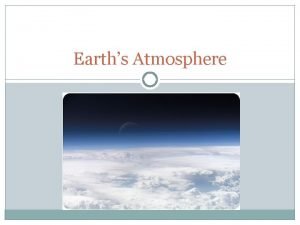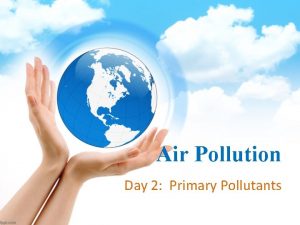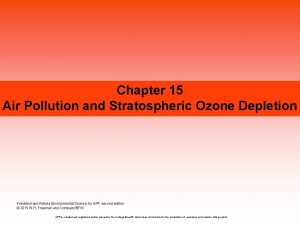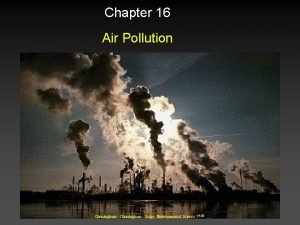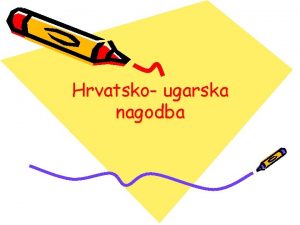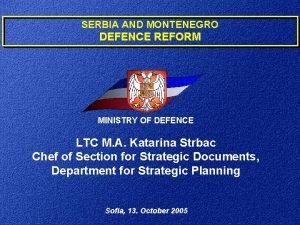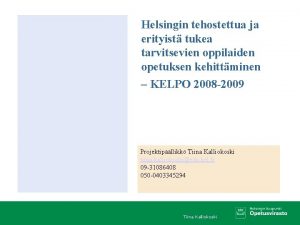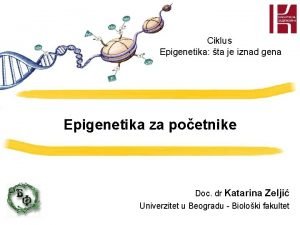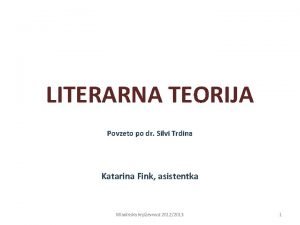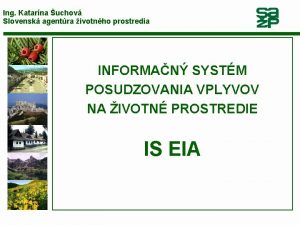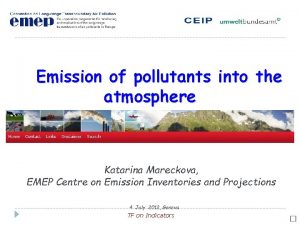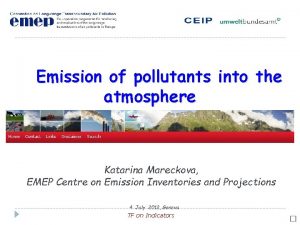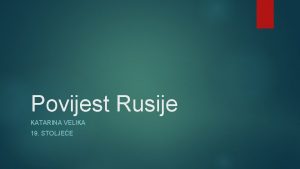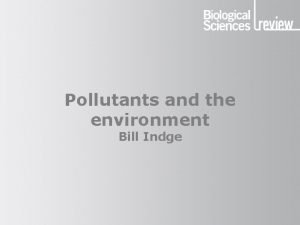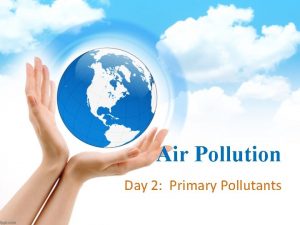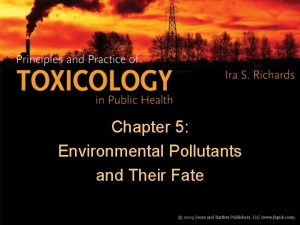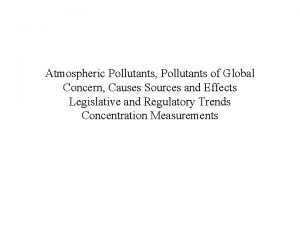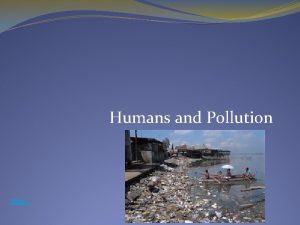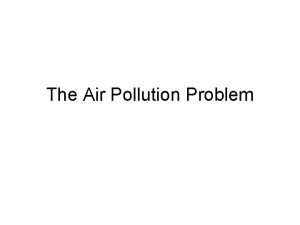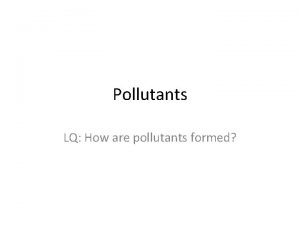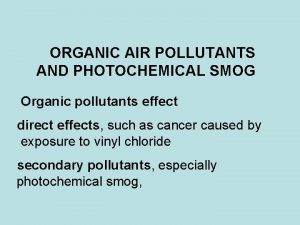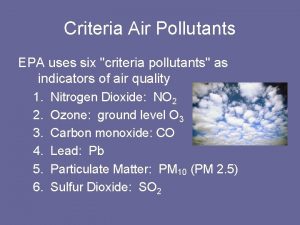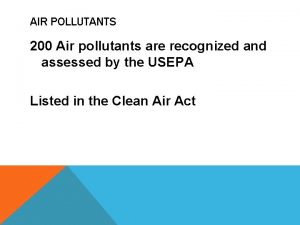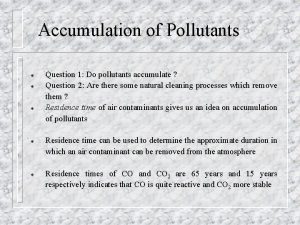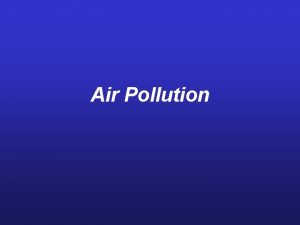Emission of pollutants into the atmosphere Katarina Mareckova































- Slides: 31

Emission of pollutants into the atmosphere Katarina Mareckova ETC ACM , Umveltbundesamt 24 Sept 2012, Chisinau ENPI workshop �

Content �Introduction �What is NIS and why we need it �Estimation and reporting of emissions �Status of reporting in EECCA

What is National Inventory System (NIS) �A national inventory system incorporates all the elements necessary � to estimate, � report � and archive emissions (and sinks), i. e. Legal arrangements Institutional Procedural arrangements High quality inventory that meets needs of policy-makers, researchers and public

Institutional and procedural arrangements Data providers (Stat. Off, Industies, … Leading institution Team coordinator Sectoral experts Strategy / workplan in place QA/QC plan developed QA/QC DB mana ger Reporting system in place Cooperating institutions Universitie s Consultan ts Research inst. Documentation and Archiving system in place

Legal arrangements (Act , decree, …) Define responsibilities (legal entity) Establish system for collecting the data Ensures resources Ensures access to inventory data for inventory compilers

Inventory process, Inventory cycle Develop improvement strategy Assessment of current status Inventory Planning Inventory Management High quality inventory that meets needs of policy-makers, researchers and public Inventory Preparation

What is an emission, emission source � Releases to air occurring by anthropogenic activities (combustions of fuels, agriculture activities, mining, industrial processes, leakages from equipment's, pipelines…) Type of source �Point sources �Area sources �Linear sources � Natural emissions (volcano eruptions, forest fires, releases from soil, vegetation, . . (diffuse emissions)

Emission estimation A. Direct measurements of emissions e. g. from chimney measurements , biogas measurements from landfills, etc… B. Estimation by calculation � Emission factor (mass pollutant per unit activity) � Activity data C. Inverse modeling (e. g. based on air quality measurements)

Concept of Key categories (80% to national total) • 1 A 1 a Public Electricity and Heat Production”, • “ 1 A fi Stationary Combustion in Manufacturing industries and Construction: Other” • “ 2 C 1 Iron and Steel Production”. • 1 A 2 b Stationary Combustion in Manufacturing Industries and Construction: Nonferrous Metals • 1 A 4 bi Residential: Stationary plants

Existing reporting formats http: //www. ceip. at/reporting-instructions/annexes-to-the-reporting-guidelines/ � NFR 09 sectors, categories � (E-PRTR activities, UNFCCC CRF categories, …)

Spatial distribution of emissions SOx NH 3

Gridded emissions - Contribution of SNAP (GNFR) sectors to total emissions � � � � � S 1 - Combustion in energy and transformation industries, S 2 -Non-industrial combustion plants, S 3 -Combustion in manufacturing industry, S 4 -Production processes, S 5 -Extraction and distribution of fossil fuels and geothermal energy S 6 -Solvent use and other product use, S 7 -Road transport S 8 -Other mobile sources and machinery, S 9 -Waste treatment and disposal S 10 -Agriculture

Reporting of LPS

Quality parameters of emission inventory T TCCCA � Timeliness � Transparency � Consistency � Comparability � Completeness and � Accuracy Quality control � Review process of emissions inventories is established under all Conventions and protocols � Automated tests on imported of the data � Semi-automated tests on completeness, consistency � In-depth review of methods, EF and AD, documentation

Review process under CLRTAP/EEA – T TCCCA � Methods and procedures for the technical review of air pollutant emission inventories reported under the Convention and its protocols (Review Guidelines EB. AIR/GE. 1/2007/16) � Stage 1 - automated tests, Country reports posted on the web during March � Stage 2 - S&A country reports posted in May http: //www. ceip. at/review-results-2012/ 3 – Centralised in - depth review of selected inventories � Stage � Summary of S 1 and S 2 findings: In CEIP/EEA technical report Inventory review 2012 http: //webdab 1. umweltbundesamt. at/download/Reports/2012/Inventory. Rep ort 2012_for. Web. pdf

Review results S 1 – S 2 � � http: //www. ceip. at/reviewresults/review-results-2012/ EEA & CEIP report Inventory Review 2012

Stage 3 in-depth centralized review Ø Centralized review is review of quantitative and qualitative information of selected inventories by pollutant, country or sector Ø Joint activity of EMEP/CEIP , EEA and Parties Ø The work plan is (annually) approved by the EMEP EB � CEIP � Coordination of the whole process � Technical support of ERT � Communication with Parties � Publication of final reports � CEIP/TFEIP/EEA � Guidance for reviewers, transcripts and templates for review reports http: //www. ceip. at/review-of-inventories/centralised-review-stage-3/

Stage 3 review - long term plan 2013 Belgium, France , Latvia, Lithuania, Monaco, Norway, Poland, Portugal, Romania, Sweden 2014 Bulgaria, Cyprus, Denmark, Finland, Hungary, Ireland, Italy, Kazakhstan, Russian Federation, Spain 2015 Armenia, Azerbaijan, Belarus, Czech rep. , Greece, Germany, Netherlands, Slovakia, Slovenia, and Ukraine 2016 2017 Bosnia and Hercegovina, Croatia, Estonia, Kyrgyzstan, Luxembourg, FYR of Macedonia, Republic of Moldova, Switzerland, United Kingdom and Turkey Albania, Austria, Georgia*, EU, Iceland, Liechtenstein, Malta, Montenegro, Serbia

Assessemnt of IIRs Transparency / user friendliness �NIS/ Inst. arrangements Design �Completeness info. �KCA IIR Template �Uncertainty info. No. of pages �Trends explanation Reporting last 5 years Reporting 1995 -2012 Completeness of data in Web. Dab �Improvements �Methodology description �Recalculations expl. �Planned improvements �Documentation/ references �Projections �Gridded/ LPS

Assessement of IIRs

IIR AWARDS 2010 -2012

Reporting of emissions, reporting obligation � LRTAP Convention (21 pollutants: acidifying, ozone precursors, PM, HMs, POPs); 51 Parties � 8 protocols � UNFCCC (GHGs: � CO 2, N 2 O, CH 4, F-gases) 123 Parties Kyoto protocol � Montreal protocol – Ozone depleting pollutants � Aarhus Convention - � E-PRTR protocol – industrial point sources – 91 pollutants � ……. � EIONET framework (EEA) – annual priority data flows

Data flow EMEP SB inventories Notification forms UNECE Secretariat Country reports MS inventories Parties to the CLRTAP modelers ata dd e dd i r G tin g Rep. Dab Status reports EMEP EB tes Central DB rev iew EEA, ETC ACC Eurostat Surrogate data UNFCCC CRF

Resources for emission inventory compilers:

Existing Guidance, Guidebooks and Tools � EMEP/ EEA Inventory Guidebook EN and RU http: //www. eea. europa. eu/publications/emep-eea-emission-inventoryguidebook-2009 � http: //www. eea. europa. eu/publications-ru/emep-eea/ � EMEP Emission Reporting Guidelines EN and RU ECE/EB. AIR/97 http: //www. ceip. at/fileadmin/inhalte/emep/reporting_2009/Rep_Guidelines_EC E_EB_AIR_97_e. pdf � Annexes to the Guidelines I to VI including: reporting formats (NFR 09 tables) � IIR template � � Collect. ER emission inventory DB � COPERT road transport software

Completeness of data in CEIP DB Status as of 1 -09 -2012 NFR 09 NFR 02 SNAP National Total

Emission trends 1990 -2012 100% NOx 90% Armenia 80% Azerbaian 70% Belarus 60% Georgia 50% 40% Rep. of Moldova 30% Russian Fed. 20% 10% 2010 2009 2008 2007 2006 2005 2004 2003 2002 2001 2000 1999 1998 1997 1996 1995 1994 1993 1992 1991 1990 0% Ukraine

Emission trends 1990 -2012 180% Armenia DIOX 160% Belarus 140% 120% Georgia 100% Rep. of Moldova 80% Russian Fed. 60% 40% Ukraine 20% Note: Azerbaian and Ukraine did not report. 2010 2009 2008 2007 2006 2005 2004 2003 2002 2001 2000 1999 1998 1997 1996 1995 1994 1993 1992 1991 1990 0%

Emission trends 1990 -2012 140% 120% PM 10 100% Belarus 80% Georgia 60% Rep. of Moldova 40% Russian Fed. 20% Note: , Armenia, Azerbaian and Georgia, did not report. 2010 2009 2008 2007 2006 2005 2004 2003 2002 2001 2000 1999 1998 1997 1996 1995 1994 1993 1992 1991 0% 1990 Ukraine

Emission trends 1990 -2012 Datapoint of Armenia in 2007 was 3476% 140% Hg 120% Armenia 100% Belarus 80% Rep. of Moldova 60% Russian Fed. 40% Ukraine 20% Note: Azerbaian and Georgia did not report. 2010 2009 2008 2007 2006 2005 2004 2003 2002 2001 2000 1999 1998 1997 1996 1995 1994 1993 1992 1991 1990 0%

Discussion items � How to improve quality of reported emissions � How to ensure /improve communication between data providers and inventory compilers � Where are the problems ? � AD : accessibility, availability, completeness, confidentiality, …. . � EFs : applicability, uncertainty, …. � Tools: guidance, software, literature, database, . . � Legal barriers, … � awareness of stakeholders (decision maker, data providers…) � What can we do?
 Trees
Trees Primary pollutants and secondary pollutants
Primary pollutants and secondary pollutants What is primary and secondary air pollution
What is primary and secondary air pollution Why do scientists divide the atmosphere into layers
Why do scientists divide the atmosphere into layers Scientists divide the atmosphere into how many layers?
Scientists divide the atmosphere into how many layers? Air pollutants
Air pollutants Primary vs secondary pollutants
Primary vs secondary pollutants Pradushan paribhasha
Pradushan paribhasha Benjamin cummings
Benjamin cummings Short lived climate pollutants
Short lived climate pollutants Stock pollutants
Stock pollutants Secondary pollutants examples
Secondary pollutants examples Definition of environmental pollution
Definition of environmental pollution Inorganic gaseous pollutants of air
Inorganic gaseous pollutants of air Indoor air pollutants
Indoor air pollutants Inorganic gaseous pollutants of air
Inorganic gaseous pollutants of air Secondary pollutants
Secondary pollutants Major air pollutants
Major air pollutants Secondary air pollutants
Secondary air pollutants Solar energy and the atmosphere
Solar energy and the atmosphere What are the secondary air pollutants
What are the secondary air pollutants Primary and secondary pollutants difference
Primary and secondary pollutants difference Primary vs secondary pollution
Primary vs secondary pollution Parovi 9 katarina
Parovi 9 katarina Katarina strbac
Katarina strbac Katarina milanovic
Katarina milanovic Katarina von renteln
Katarina von renteln Moji geni
Moji geni Katarina jegdic
Katarina jegdic Katarina fink
Katarina fink Katarína šuchová
Katarína šuchová Katarina bojanic
Katarina bojanic
